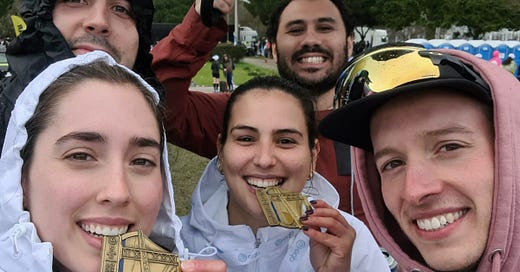You got your medal... Now, how to recover?
Recovery after a race is crucial for repairing muscles, replenishing energy stores, and preventing injury. What can we do to make it as efficient as possible?
An update on my first race of the year
Last Sunday, I was with some friends doing the EDP Meia Maratona de Lisboa (half-marathon) and I did a PR🏅. Racing was hard and taking the right steps in the hours and days following significantly impacted my performance and overall well-being.
A highlight of this race was that my girlfriend and two friends were guided by me in their training and both my friends enjoyed their first half-marathon and my girlfriend reduce 15 minutes to her last half-marathon which is a huge accomplishment.
Also, the expected weather was rainy, cold and windy but we only saw sunshine, no rain and almost no wind!
Immediate Post-Race Actions
Recovery after a race is crucial for repairing muscles, replenishing energy stores, and preventing injury.
Cool Down: Engage in light jogging or walking for 10-15 minutes to help flush out lactic acid and prevent stiffness.
Hydrate: Replenish lost fluids with water or an electrolyte-rich drink.
Refuel: Consume a balanced mix of carbohydrates and protein within 30-60 minutes to kickstart muscle repair.
Stretch and Massage: Gentle stretching and a massage can aid in muscle relaxation and reduce soreness. Not for someone that is ticklish.
The First 24 Hours
Rest and Sleep: Prioritize quality sleep to allow your body to repair tissues, regulate hormones and overall stress.
Compression Gear: Wearing compression socks or sleeves can improve circulation and reduce muscle fatigue.
Ice and Elevate: If you experience swelling or discomfort, ice the affected areas and keep them elevated. Remember RICE from an earlier post?
Why Every Triathlete Needs a Recovery Plan: Rest Days Done Right 💤🏊♀️🚴♂️🏃♂️
That’s right, recovery isn’t a break from training; it’s part of the training. Without it, you’re like a car running on fumes—eventually, you’ll stall.
The Days Following the Race
My coach and nutritionist both help me with this task and if you don’t have access to one, try to moderate a training load and keep an eye on your nutrition.
Active Recovery: Engage in light activities like swimming, yoga, or cycling to maintain blood flow without overloading your muscles.
Nutrition: Focus on anti-inflammatory foods rich in antioxidants, such as fruits, vegetables, and omega-3 fatty acids.
Hydration: Continue to drink plenty of water and monitor your electrolyte balance.
Long-Term Strategies
I’ve found some strategies that work for me and give it a try if you fail to recover after a race.
Strength Training: Incorporate resistance exercises to improve muscle strength and prevent future injuries. One time a week done right can do wonders.
Regular Massage and Foam Rolling: These can help release muscle tension and enhance flexibility. Put on a Youtube video or a movie and in no time you’ve got 20 minutes of flexibility done.
Mental Recovery: Reflect on your race experience and set new goals to maintain motivation. I’ve got only one thing in my mind: Challenge Roth 2025.
Common Mistakes to Avoid
Skipping Cool-Down: Can lead to muscle tightness and increased soreness. When I don’t feel like doing it, I trick myself and do a mental game of “It’s only 1km more or 5 minutes more” and can easily put the time in.
Overtraining: Jumping back into intense workouts too soon can cause injury. Listen to your body!
Neglecting Nutrition and Hydration: Without proper nutrients and fluids, your recovery will be slower and less effective. Once again, listen to your body and to hunger and thirst cues.
Effective recovery is not just about rest; it’s a holistic approach that includes proper nutrition, hydration, active recovery, and mental well-being. Give these tips a try and hopefully you’ll enhance your performance, reduce the risk of injury, and be ready for your next challenge.






